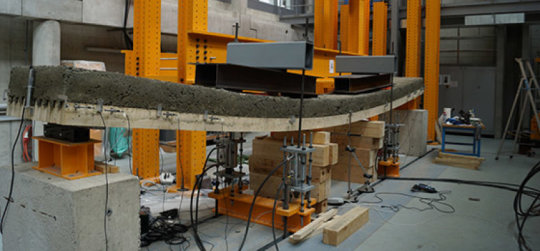News
Concrete from Wood
A new type of concrete has been created that largely consists of wood. The building material offers the construction industry new possibilities and is based in large part on renewable resources.

Houses can be made of wood, as they were in the past -- or of concrete, as they are today. To build for tomorrow, the two building methods are being combined: these hybrid structures, which contain both wood and concrete elements, are becoming increasingly popular in contemporary architecture.
In the context of the National Resource Programme "Resource Wood" (NRP 66), Swiss researchers have now developed an even more radical approach to combining wood and concrete: they are fabricating a load-bearing concrete which itself consists largely of wood. In many blends, the volume fraction of the wood is over 50 percent.
Cement-bonded wood products have been around for more than a hundred years. Yet previously they were used only for non-load-bearing purposes, such as insulation. Daia Zwicky, head of the Institute for Building and Environmental Technologies at the School of Engineering and Architecture of Fribourg, wondered whether it wasn't time for a more ambitious use of wood-based concrete.
Together with his team, Zwicky experimented with the content and granularity of the wood as well as diverse additives and subsequently subjected the various blends to rigorous tests. The main difference from classical concrete is that the gravel and sand content is replaced with finely ground wood. In other words, sawdust rather than small stones is mixed in with the cement. Thanks to the high wood content, the new building materials show good flame retardance and act as thermal insulation. "They weigh at most half of what normal concrete weighs -- the lightest of them even float!" says Zwicky. Moreover, as the materials are based largely on renewable resources, after dismantling they can be reused as a source of heat and electricity. The wood content can be burnt in waste incineration, although for everyday use it conforms to fire protection standards.
Initial 1:1 stress tests show that the new wood-based concrete is also suitable for slab and wall elements and can provide a load-bearing function in construction. The process is also suited to prefabricated units. In this context, in particular, the Fribourg group would like to deepen their expertise through a broader range of tests. The researchers want to find out which wood-concrete composite is best for which applications, and how it can be produced efficiently.
Leave Message
If you have any problems or questions about our products or need our support and assistance, please feel free to write us, we will reply to you within 24 hours, and never reveal your information to the third party. Thank you!
PRODUCTS SEARCH
Quickly find productPRODUCTS LIST
- QMJ-10A Egg-laying Block Ma...
- QTY4-30 Egg Laying Block Ma...
- QTJ4-40 Semi-auto Block Mak...
- QTJ4-35 Semi-auto Block Mak...
- QTJ4-26 Semi-auto Block Mak...
- QTJ4-25 Auto Block Making M...
- Concrete Mixing Pump
- Trailer Concrete Pump
- HY600 Self-loading Concrete...
- HY400 Self-loading Concrete...
